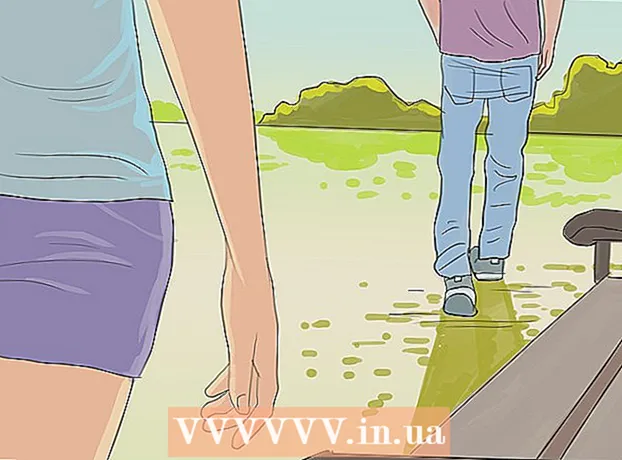Author:
Randy Alexander
Date Of Creation:
25 April 2021
Update Date:
24 June 2024

Content
An electric shock occurs when an electric current is passed through the body. The consequences of an electric shock can vary greatly, from numbness to immediate death. Knowing what to do in an electric shock can make the difference between life and death.
Steps
Part 1 of 4: Ensuring Safety
Observe the accident area carefully. You may want to rush to save lives, but if the danger of electric shock persists, you will only injure yourself. Spend some time assessing the scene and noting any obvious hazards.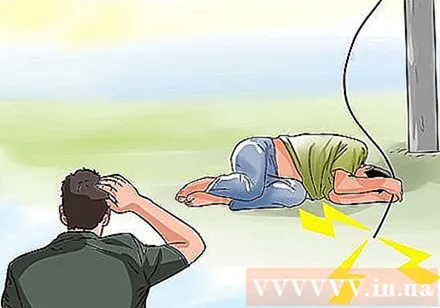
- Check the power supply. Observe whether the victim is still exposed to the power source. Remember that electrical current may flow from the victim into you.
- Never use water, even during a fire, as it can conduct electricity.
- Do not enter areas where electrical equipment is active while the floor is wet.
- Use a fire extinguisher exclusively for electric fires. Fire extinguishers are labeled C, BC or ABC.

Call ambulance. Quickly calling for help is very important. The earlier you call, the faster help will come. When you call, try to explain the situation as calmly and clearly as possible.- Explain electric shock and related emergency situations so that the emergency team has the best preparation.
- Try not to panic. Staying as calm as possible will help you communicate correctly.
- Speak clearly. Emergency services need clear and accurate information. Talking too quickly can lead to misunderstandings, and waste valuable time in vain.
- Provide your exact address and phone number.
- Most countries have easy-to-remember emergency numbers. Below are a few examples:
- Vietnam - 115
- USA, Canada - 911
- UK - 999
- Australia - 000

Disconnect power. If it is possible to do so safely, disconnect the power supply. Don't try to save someone near the high-voltage line. To disconnect the power box, circuit breaker or fuse cabinet is the first option. Follow the steps below to turn off the power using an automatic circuit breaker:- Open the breaker box. Look for the square box with the handle located above the fuse cabinet.
- Grab the handle and pull it towards the other side, similar to the lamp work.
- Try turning on a light bulb or other electrical device to make sure the power is off.

Isolate the victim from the power source. Do not touch them, even when using non-conductive equipment, if the current has not been interrupted. Once there is no electric current remaining, use a wooden stick, rubber or any other non-conductive device to isolate the victim.- Examples of insulating materials include glass, porcelain, plastic, and paper. Cardboard is also a popular insulating material that can be used.
- Conductive materials - which allow electricity to flow through - include copper, aluminum, gold and silver.
- In the event of a victim being struck by lightning, it is safe to touch them.
Part 2 of 4: Victim Assistance
Put casualty in recovery position. Placing the person with electric shock in recovery position will ensure their airway is clear. Please follow the steps below to put the victim in the correct recovery position:
- Fold your arms closer to you at an appropriate angle from the body.
- The other hand is under one side of the head. The back of the hand touched the cheek.
- Bend the pillow away from you at an appropriate angle.
- Roll the victim aside. The arm above will support the head.
- Lift the victim's chin and check the airway.
- Stay with the victim and watch for their breath. Once restored to recovery position, do not move the victim as it may exacerbate the injury.
Cover the victim and wait. The victim quickly loses heat. Therefore, you should use net blankets to keep the person warm. Together waiting for emergency to arrive.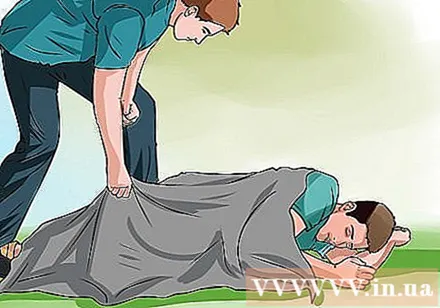
- Do not cover the victim's body with a major wound or untreated burn.
- Be gentle when covering the victim with a blanket.
- When the emergency comes, give them the information you have. Quickly explain the source of danger. Note every wound you know and the timing of the accident. Do not attempt to intervene once the victim has been admitted.
Talk to the victim. Try to talk to the victim to get a better understanding of their situation. The more you learn, the more useful you will become. Pay attention to every response of the victim and be ready to communicate when emergency arrives.
- Make your own judgment and, at the same time, ask the victim what happened. Ask if they have difficulty breathing or have pain in any position.
- Ask where the pain originated. Thanks to that, you will be able to identify any wound or burn.
- If casualty is unconscious, check the airway and listen for their breathing.
Body examination. Examine the victim's body, starting with the head and moving down the neck, chest, arms, abdomen, and legs. Watch for any other noticeable burns or injuries. Tell the emergency response team when they arrive.
- Do not correct or move any painful or traumatic areas. Do not touch the burn. Moving the victim can aggravate the injury.
Stop bleeding. If the victim bleeds, try to stop or slow the bleeding. Use a clean towel to apply pressure directly to the wound. Continue pressing until the bleeding stops.
- When the towel gets soaked in blood, don't change, but apply another layer of towel on top.
- Raise the bleeding arm or leg above the position of the heart. Do not move if in doubt.
- Once the bleeding has stopped, wrap a towel with a bandage to fix it.
- Wait for emergency services to arrive, providing information about your injury and what to do about it.
Call emergency services again if casualty goes wrong. When you notice any change in the victim's condition or find any new injuries, call the ambulance and ask for instructions. Updating information will help the emergency team act better.
- When the situation gets worse, the operator will likely take your situation priority.
- If the victim stops breathing, the operator will probably tell you how to perform cardiopulmonary resuscitation (CPR). Don't panic, follow all given directions exactly.
Part 3 of 4: Safely Conducting Untrained CPR
Remember to check ABC (airway - breathing, breathing - breathing, circulatory - circulation). In an emergency situation, it is very important to check the person's airway, breathing and circulatory system before performing CPR. This process is also known as ABC. You can check it by doing the following:
- Check the victim's airway. Look for signs of injury or any interference.
- Check your breathing. Observe to see if the victim is breathing normally by placing the ear near his or her nose and mouth, listening for every breath. Do not do CPR while the victim is breathing or coughing.
- Perform CPR if the victim is not breathing. When the victim stops breathing, begin CPR immediately.
Nerve evaluation. Although it will be reviewed by a medical professional, it is helpful to determine the response level in the victim and pass the information on to the emergency team. Neurological status is divided into the following four levels:
- A - alert. The victim is awake, able to communicate and is aware of everything around him.
- V - reply (voice responsive). Victims may respond verbally to questions, but they may not be alert enough or aware of what is going on.
- P - pain responsive. Victims have a number of reactions to pain stimuli.
- U - unresponsive. The victim loses consciousness and does not respond to questions or pain stimuli. If the victim is in a coma, you can do CPR. Do not use CPR on people who are awake and breathing.
In position. You and the victim need to be in the right positions when performing CPR. Try the steps below to make sure you're both in position for the squeeze: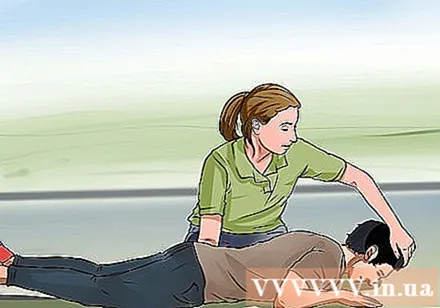
- Lay casualty on his or her back and tilt her head back.
- Get on your knees near the victim's shoulder.
- Place palms on center position, between nipples.
- Put your other hand on top. The elbows are straight, the shoulders are straight above the hand.
Start pressing down. Once in place, you can now start squeezing the heart. Pressing the heart can save lives of the victim, ensuring oxygenated blood continues to be pumped to the brain.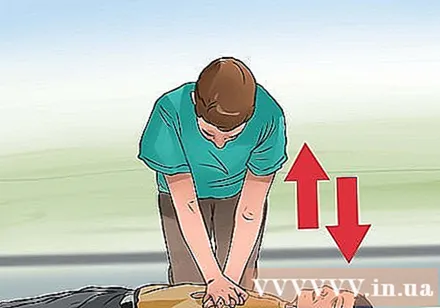
- Not just the arm, but also the weight of the upper body when pressed straight to the chest.
- Press down at least 5 cm.
- Press hard, at a rate of 100 squeezes per minute. Continue until breathing returns or emergencies arrive.
Part 4 of 4: Handling Burns
Seek medical attention for electric shock victim. Even minor burns in the event of an electric shock require medical attention. Do not self-treat the victim. Call an ambulance or take them to the nearest hospital.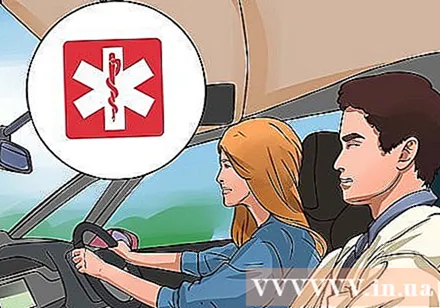
Determine the area of the burn. Burn wounds have certain characteristics to identify. Look for wounds that show one or more of the following:
- Indians.
- Peeling skin.
- Blistering.
- Swelling.
- White or charred skin.
Clean the burn. Electricity will normally flow into and out of the body in two different positions. Use all your power and examine the victim thoroughly. Once determined, cool the burn with cold water for ten minutes.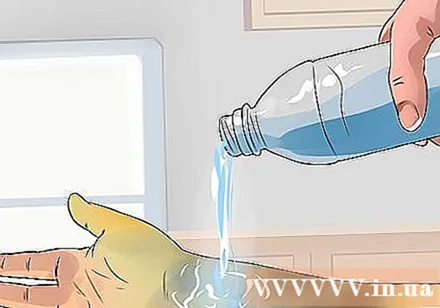
- Use only clean water to avoid any risk of infection.
- Do not use ice, hot or cold water, any creams or ointments. The heat-sensitive burnt skin is too hot or too cold and the cream can make it difficult to recover.
Unload clothing and jewelry. Unloading clothing and jewelry near the burn is important, helping to prevent further damage. Some clothing or jewelry may remain hot from electric shock and may cause injury ..
- Do not try to get any melted piece of paper or cloth stuck to the burn.
- When burned, do not cover the victim with a blanket as it can lead to infection.
Cover the burn. Shielding will help protect the burned area from the risk of further damage and reduce the risk of infection. Try to use one of the following: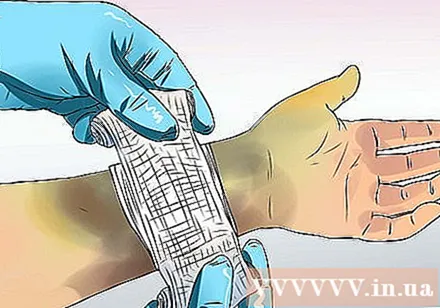
- Sterile gauze bandages
- Clean cloth
- Avoid using towels or blankets
- Don't use tape
Wait for emergency help. Once the victim is settled, stay with them and reassure them. Don't forget to keep the emergency team up to date on burn treatment.
- Keep the phone with you in case you need to make an urgent call. Try to keep an eye on the accident status and do not leave them alone.
Advice
- Make an effort to remain calm.
- Give the emergency team as much detail as possible.
- Stay with the victim and keep track of their status.
- Notify emergency services of any changes in the victim's situation.
- Never do electrical work alone. In the event of an accident, the presence of a co-worker can save your life.
Warning
- Always make sure the current is disconnected before helping the victim.
- Do not apply ice, butter, ointment, medicine, fluffy bandages or bandages to the burn.


